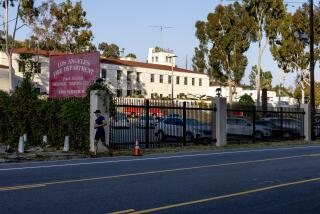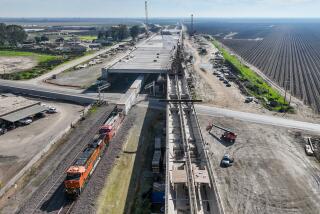ANAHEIM : Railroad Station to Be Renovated
Union Station, with its white Spanish arches and red-tile roof, seems almost forgotten at the edge of defunct railroad tracks in an abandoned neighborhood.
But unlike so much of old, historic Anaheim, the 67-year-old railroad station will not be razed for development, but incorporated into a renovated downtown.
In a plan approved by the City Council last week, the station will be saved and included in downtown redevelopment, which includes extensive commercial and residential building.
Within the next month, Union Station will be moved from its current spot at 625 E. Lincoln Ave. to 210 S. Atchison St., just across the street. The new location will be where Center Street ends, complementing the new homes to be built there.
“It’ll be the jewel of Center Street,” said Richard Bruckner, a Redevelopment Agency official familiar with the project. “It’s something everyone has agreed would be a nice thing to save.”
Built in 1923, the station saw generations of passengers travel from Los Angeles to Anaheim and south to Santa Ana and San Diego. It wasn’t the first station built in the city--the Southern Pacific station was built when the city was founded in 1875--but became an important railway link for passengers and orange crops in growing Orange County.
Newspaper accounts over the years indicate that the station survived bitter struggles, which often threatened its existence after the railroad company stopped service to Anaheim in 1971. In February, 1972, the station was to be razed, only to be spared by the efforts of protesters, including then-City Councilman Don R. Roth.
But plans to move it were thwarted in the early ‘70s after building inspectors deemed it unfit for transport.
Relocating and renovating the building--which was last used by CM School Supply Co.--will cost just under $500,000.
Bruckner said the city community services department will conduct surveys to see if the old station might be converted into a child-care center to serve the nearly 400 new homes, apartments and townhouses in the redevelopment area.
If there is insufficient demand for a child-care center, the station might be used for offices or another social service, he said.
More to Read
Sign up for Essential California
The most important California stories and recommendations in your inbox every morning.
You may occasionally receive promotional content from the Los Angeles Times.











